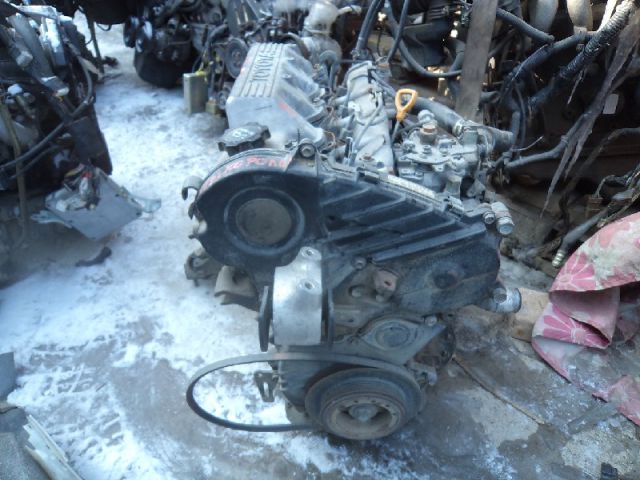
Toyota 1C, 1C-L, 1C-LC, 1C-TL, 1C-TLC engines
Content
The 1C diesel family manufactured by Toyota Motors began to be installed on the company's cars in 1982 and lasted 10 years on the assembly line. The internal combustion engine is a four-cylinder in-line engine with a working volume of 1839 cm³.

Initially, the task was to create an extremely simple, inexpensive, economical diesel engine for cars in the budget segment. The motor was installed on a number of right-hand drive economy class cars, such as:
- Nice;
- Corolla
- Corona;
- LiteAce/TownAce.
The transverse engine version was called 1C-L, equipped with an exhaust gas catalytic converter - 1C-LC. Turbocharging is denoted by the letter T. The 1C-TLC version denotes a transversely mounted 1C engine equipped with a turbine and a catalyst.

Engine design features
The cylinder block is made of cast iron. Cylinders are practically "square", when the piston stroke is equal to the diameter of the cylinder. This geometry reduces the sensitivity to loads.
The head is made of aluminum, it has 8 valves, two for each cylinder. The camshafts are driven by a belt. There are no hydraulic valve clearance compensators. Fore-chamber injection.
The belt drives not only the camshaft, but also the high pressure fuel pump, oil pump, pump. Because of this, it has a large length and experiences excessive loads, which often leads to a broken belt. As a result, valves bend.
Engines are prone to overheating. This is due not to the quality of the materials, but to the high heat load of the motors. Low-power motors are constantly working at their limit. For example, a turbocharged 1C-T with 73 hp. installed on Toyota Camry. It is obviously hard for him to pull such a mass.

Cracks in the cylinder head due to overheating are considered the most unpleasant malfunction of 1C motors. They are caused by a design flaw in the cooling system, and not by the quality of the cylinder head. The expansion tank of these internal combustion engines is located below the level of the head.
When heated, the coolant flows into the expansion tank. During subsequent cooling, the reverse process should occur, the cooled antifreeze should fill the channels of the block head. But if the valve installed on the radiator filler cap is depressurized, which happens over time, atmospheric air will be sucked into the block head instead of liquid from the expansion tank.
As a result, the normal circulation of fluid in the most heat-loaded part of the engine - the cylinder head - is disrupted. This leads to local overheating and the formation of cracks. In the turbocharged version of the engine, the turbine is cooled with antifreeze, and also falls into the number of "victims". Due to overheating, the antifreeze-cooled pump cannot maintain the required pressure of the diluted oil, and the turbine seat experiences oil starvation.
Further, overheating increases exponentially. The head of the block, constantly overheating, warps, the tightness of the connection with the cylinder block is broken. Antifreeze is mixed with oil and the gasket needs to be replaced, or even edge grinding is required.
Getting rid of this defect is as easy as shelling pears: you need to raise the expansion tank above the level of the head, and the air will stop flowing into the cooling system.
The rotary oil pump lubrication system has a long oil receiver, which also contributes to insufficient lubrication immediately after start-up until all channels are filled. Pumps immersed in oil are preferred.
Advantages and disadvantages of ICE 1C
Special advantages of this motor, except for the low price, experts do not note. With a stretch, the efficiency and insensitivity to fuel quality of versions without a turbine and a catalytic converter of exhaust gases can be considered as such. It is not surprising that these engines were installed only on cars for the domestic market. European counterparts were significantly superior to 1C motors in all respects.
There are several significant disadvantages:
- low resource caused by low power and, accordingly, high loads;
- lubrication system with a short delay in oil supply after start-up;
- weak timing belt;
- a defect in the cooling system, leading to cracks in the cylinder head with a run of about 100 thousand km;
- short-lived turbine with costly replacement.
Despite these shortcomings, with proper handling and gentle operation, 1C motors are able to travel 150-200 thousand km.
Technical specifications
Below are the main parameters of engines with and without a turbine, not equipped with a catalyst.
| Engine | 1C | 1-TC |
| Working volume, cm³ | 1839 | 1839 |
| Supply system | fore camera | fore camera |
| Maximum power, hp | 65 | 75 |
| Torque | 118 Nm | 145 |
| Cylinder diameter, mm | 83 | 83 |
| The piston stroke, mm | 85 | 85 |
| Compression ratio | 23 | 23 |
| Gas distribution | SOHC | SOHC |
| Hydraulic compensators | no | no |
| Phase regulators | no | no |
| Turbocharging | no | Yes |
| butter | 3.8 liters 5W-40 | 3.8 liters 5W-40 |
| fuel type | diesel | diesel |
| Environmental class | EURO 0 | EURO 0 |
| Approximate resource, thousand km | 200 | 180 |
Engines with a transverse arrangement do not differ in characteristics.
Maintainability of C series motors
These engines are quite simple in design, so repair does not cause any particular difficulties. Turbocharged engines are more complicated, the repair of such units is more expensive. A complete overhaul can be carried out within 120 thousand rubles. Buying a contract engine seems inappropriate. Motors do not have a large resource, so it is not easy to find a unit in good condition.

